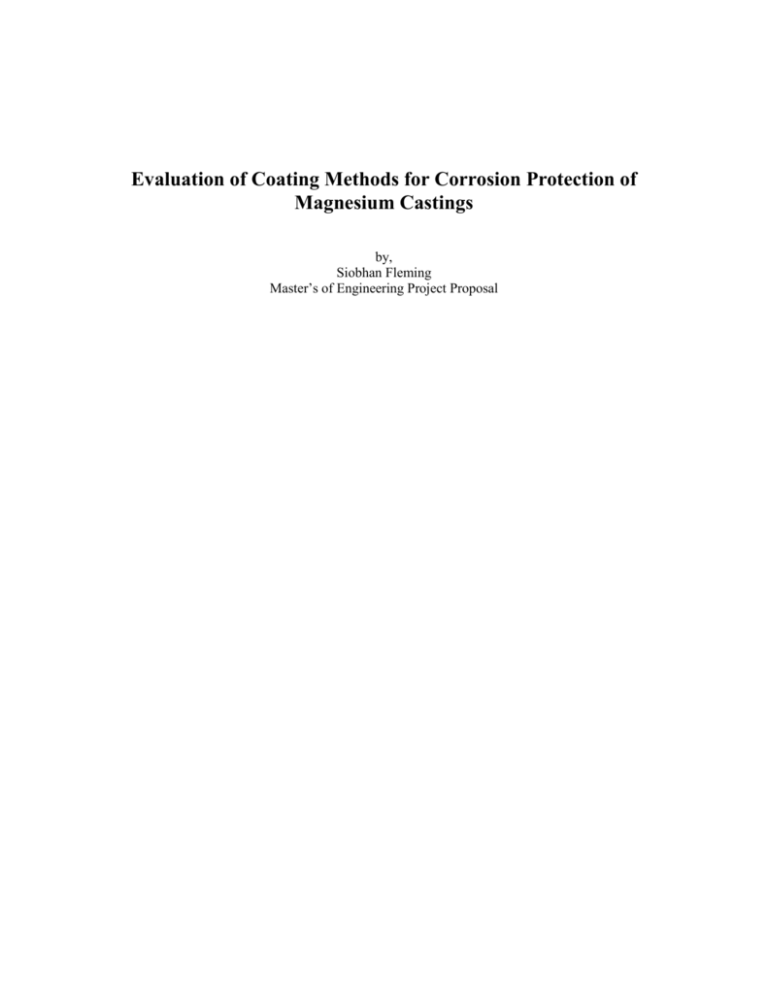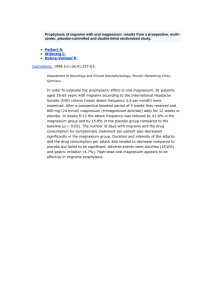
Evaluation of Coating Methods for Corrosion Protection of
Magnesium Castings
by,
Siobhan Fleming
Master’s of Engineering Project Proposal
Abstract:
Magnesium is an excellent readily available light metal alloy for engineering applications
when weight is a critical design element. It is a strong and light material that can be cast into
thinner parts than aluminum. However, it can be volatile at high temperatures and extremely
corrosive in wet environments. Magnesium parts have specific benefits that are required in
design applications when magnesium is in alloyed form and has a protective coating.
Sometimes only a coating or alloyed magnesium is needed in design, but both have benefits.
When alloys and coatings are introduced into the design there is more evaluation required by
the designer. Coatings may not offer enough protection depending on applications or may
endanger the health and safety of the part manufacturers or operators. This paper evaluates
different coatings for magnesium parts and the advantages and disadvantages to each type.
Introduction/Background
Magnesium is an excellent light metal alloy as it is readily available commercially and it
is the lightest of all the light metal alloys. It is readily found in the earth’s ocean and the crystal
structure is hexagonal close packed (Figure 1) which restricts its ability to deform because it has
fewer slip systems at lower temperatures. However, it is rarely used without being alloyed with
other metals. Some of the most common alloyed elements in commercial alloys are: aluminum,
zinc, cerium, silver, thorium, yttrium and zirconium. Magnesium can also be alloyed with rare
earth elements, which increase the strength of magnesium especially at high temperatures.
The most widely used magnesium alloy is Mg-Al-Zn.
Figure 1: Example of Hexagonal Close Packed Crystalline Structure
Magnesium alloys are good for engineering applications because they have good
strength, ductility and creep properties. Magnesium is strong and light making it an excellent
choice for aerospace applications. In particular cast magnesium alloys have specific design and
manufacturing advantages:
1. Castings can be made with thinner walls than aluminum (1-1.5mm versus 2-2.5mm).
2. Castings cool more quickly due to a reduced latent heat of fusion per unit volume.
3. High gate pressures can be achieved using moderate pressures due to the low density
of magnesium.
Figure 2: Magnesium die cast part
The major disadvantages to using magnesium for engineering applications are its
reaction to oxygen at high temperatures and corrosion. Magnesium is melted at 650ºF and as
the temperature increases the rate of oxidation of the molten metal surface increases. At
temperatures above 850ºF a freshly exposed surface can burst into flames; therefore
precautions need to be taken when machining magnesium at high temperatures. In wet
environments corrosion is a big concern during design. Pure magnesium is highly corrosive, but
when alloyed with other materials especially manganese the risk of corrosion is reduced.
Corrosion can also be alleviated by coating magnesium parts. Some examples of
coatings are rock hard and cold spray. Rock hard is a coating applied to the part after
manufacturing it is allowed to cure and provides protection against the wet environment.
However, when the coating cracks or is applied incorrectly it provides no protection and the part
will begin corroding. Cold spray is an aluminum coating that is sprayed onto the part at a cold
temperature so it fuses to the part and provides the corrosion protection of an aluminum part
without the weight.
There are a number of critical design elements that need to be evaluated when selecting
a light metal alloy. If magnesium is chosen the alloy and coating type must be well evaluated in
order to ensure the negative properties are not enhanced by the operational environment.
Problem Description
Although magnesium is an excellent light metal alloy choice for weight critical elements it
is known to be extremely susceptible to corrosion. Ways to mitigate these are in alloys, coating
materials and coating methods. There are a number of different successful combinations of
alloys, and coatings to make a corrosion resistant part, but these vary depending on your use.
Since there are so many different options an evaluation is needed in order to propose several
different successful coating types and methods for magnesium cast parts.
Methodology/Approach
An initial review of magnesium alloy types specifically alloys that are most commonly
used in castings using class materials and the text’s used in Casting and Joining and Light
Metal Alloys. A literature review will be conducted of coating types and methods. After
completing the detailed research a review of industry standards will be conducted for casting
alloys, coating types and methods. Using this industry standard along with research completed
combinations of alloys, coating types and methods can be proposed for different applications.
As part of the industry standard research the different applications will need to be defined.
Basic definitions will be automotive vs. aircraft uses and desert vs. salt water environment.
Resources Required:
Class Material from Light Metal Alloys and Casting and Joining
Class Notes
o Books:
Light Metal Alloys (Polmear) will provide background on
magnesium alloys, casting methods and coating types.
ASM Casting Handbook will provide detailed information on
casting techniques and common alloys used in casting.
Cole Library Technical Articles
These articles will provide information on industry standards for coating types
and methods.
Microsoft Office
Expected Outcomes
The outcome of this project is a detailed literature review of magnesium alloys that are
good choices for cast parts, coating types that provide excellent corrosion resistance for
magnesium and an evaluation of different coating methods that may provide better corrosion
protection. In addition some formal recommendations will be provided on the best alloy, coating
material and method for a few different applications. Finally I will be able to further the
knowledge I gained in Casting and Joining and Light Metal Alloys with specific coatings and
methods to protect against corrosion.
Milestone/Deadline List:
Tentative Project Proposal Draft: 5/31
Determine methodology and approach
Project Proposal Draft: 6/4
Evaluate Industry standards for alloys and coating types
First Progress Report: 6/11
Complete literature review of magnesium alloys
Complete review Electronic Village articles for coating types
Complete research on coating methods
Second Progress Report: 7/2
Complete any additional research required
Documentation of research completed and writing 60-70% completed
Develop final recommendations
Final Draft: 7/26
Paper completed
Preliminary Final Report: 7/30
Final Report: 8/6
References
1. Made-in-China.com
http://www.made-in-china.com/showroom/yuanlongjason/productdetailIblESqjdSMRB/China-Magnesium-Alloy-Die-Casting.html
2. Polmear, I. Light Alloys from Traditional Alloys to Nanocrystals. Amsterdam: Elsevier,
2006.
3. Magnesium Alloys – An Introduction, http://www.azom.com/article.aspx?ArticleID=355
4. ASM Handbook. Volume 15 Casting. Materials Park: ASM International, 2008.
5. Shackelford, James. Introduction to Materials Science for Engineers. Upper Saddle
River: Pearson Prentice Hall, 2005.
6. Hexagonal Close Packed Structure. http://www.miniphysics.com/2010/12/hexagonalclose-packed-structure.html
7. Ying-Liang, Cheng. Comparison of corrosion behaviors of AZ31, AZ91, AM60 and ZK60
magnesium alloys. Transactions of Nonferrous Metals Society of China: v. 19, pg 517524. 2009.
8. Li, Juanguo; Xia, Canjuan; Zhang, Yijie; Wang, Mingliang; Wang, Howei. Effects of TiO2
coating on microstructure and mechanical properties of magnesium matrix composite
reinforced with Mg2B2O5w. Materials and Design, v. 39, pg 334-337. 2012.
9. Bu, Hengyong; Yandouzi, Mohammed; Lu, Chen; Jodin, Bertrand. Effect of heat
treatment on the intermetallic layer of cold sprayed aluminum coatings on magnesium
alloy. Surface and Coatings Technology, v. 205, pg 4665-4671. 2011.
10. Wu, Chao-yun; Zhang, Jin. State-of-art on corrosion and protection of magnesium alloys
based on patent literatures. Transactions of Nonferrous Metals Society of China, v. 21,
pg 892-902. 2011.
11. Bierwagen, Gordon; Brown, Roger; Battocchi, Dante; Hayes, Scott. Active metal-based
corrosion protective coating systems for aircraft requiring. Progress in Organic Coatings
v. 68, pg 48-61. 2010.
Resources to be reviewed
1. DeForce, Brian. Materials Performance: Cold Sprayed Aluminum Coatings for
magnesium aircraft components. Materials Performance, v. 48, pg 40-44. 2009.
2. DeForce, Brian. Cold Spray Al-5%Mg Coatings for the Corrosion Protection of
Magnesium Alloys. Journal of Thermal Spray Technology, v. 20, pg 1352-1358. 2011.
3. Norton, Brian. Transactions of the Institute of Metal Finishing: Aerospace coatings –A
specialist field. Transactions of the Institute of Metal Finishing, v. 84, pg 277-278. 2006.
4. Arruebarrena, G. Materials Science & Technology Conference proceedings: Weight
reduction in aircraft by means of new magnesium castings. Materials Science and
Technology, v. 3, pg 13-20. 2005.
5. Cherkasov, V. Aluminum and magnesium castings alloys for aircraft industry. Litejnoe
Proizvodstvo, v. 6, pg 18-20. 1993.
6. Duffy, Laurence. Magnesium Alloys: The Light choice for Aerospace. Materials World,
v.4, pg 127-130. 1996.
7. Mathaudhu, Suveen. Magnesium technology: Magnesium alloys in U.S. military
applications: Past, Current and future solutions. Magnesium Technology, pg 27-30.
2010.
8. Kiebus, Andrzej.Microstructure and properties of sand casting magnesium alloys for
elevated temperature applications. Diffusion and defect data, solid state data. Part B,
Solid state phenomena, v. 176, pg 63-74. 2011.
9. Wendt, Achim. Magnesium castings in aeronautics applications – Special requirements.
Magnesium technology, pg 269-273. 2005.
10. Mukhina, Yu. Investigation into structure and properties of cast magnesium alloys for
aircraft applications. Litejnoe Proizvodstvo, v. 10, pg 17-18. 1995.






